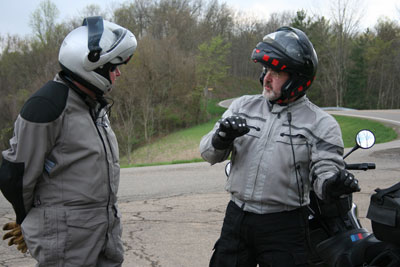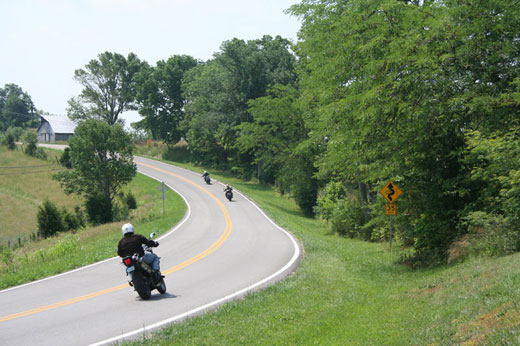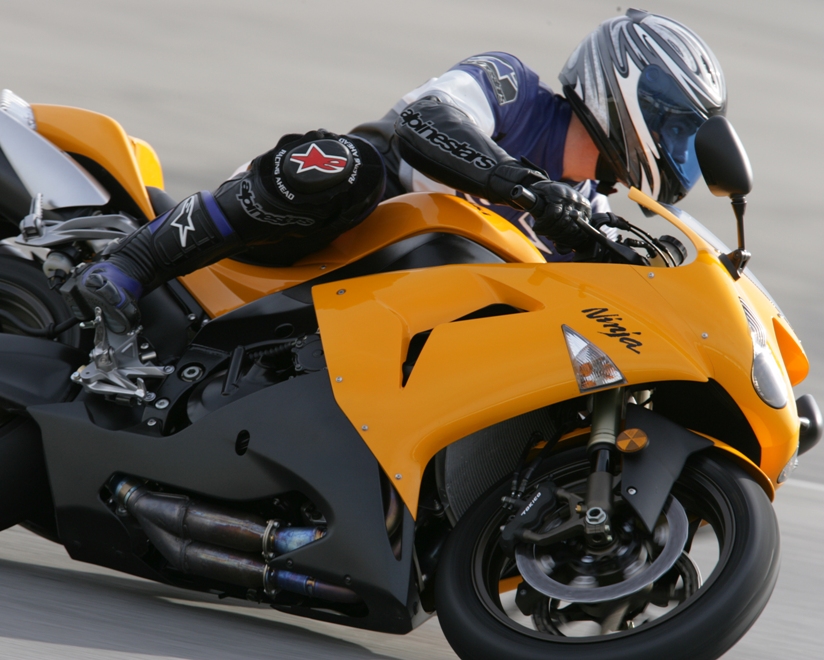
Eric Trow (right), owner and chief instructor of Stayin’ Safe Advanced Rider Training, gives a student some one-on-one instruction during a training tour.
If you’ve been around motorcycling as long as I have, you can remember a time when there were no Motorcycle Safety Foundation courses and few good books on how to ride better. Training may have been the motorcycle salesman telling you, “This is the clutch, this is the brake, one down and four up. Good luck, son.” Advice varied widely, depending on your sources, and could have been as ill-advised as the infamous, “Never touch that front brake, she’ll throw you right over the handlebar.”
Today, we have far more sources of advice, but it’s still up to us to separate the good from the bad. Having thought about all the tips and lessons thrown my way over a lifetime of riding, I’ve come to the conclusion that these are the best five pieces of motorcycling advice I’ve been given.
5. Slow down to go faster. You often hear this advice from experienced track-day riders or instructors at track-based schools. The point is that if you want to ride more quickly and still be in control, you have to be smoother, and one way to do that is to back off a notch so all your inputs, whether throttle, brakes or body position, are less abrupt and upsetting to the bike. But like most pieces of good advice, this one applies much more broadly if you think about it a while. Looking back, I see clearly that some of my most foolish mistakes happened because I was in a hurry. Like forgetting about the disc lock because my friends were waiting for me and I was rushing to leave. Or forgetting to put the spacer in the wheel because I was in a hurry to get the bike back together, stop wrenching, and start riding. Now, whenever I feel myself hurrying, whether in the garage or on the road, I force myself to slow my pace and take an extra moment. The results are always positive.
4. Ride straight. At the most elemental level, I’m talking about drinking and riding. My personal policy? Zero tolerance. Why? Because one of the first things you lose when you drink is good judgment, which is why you hear the term “bar fight” but not, for example, “coffee shop fight.” And you need judgment to know exactly how much you can drink and still be able to handle the mental and physical demands of riding. So I simplify the calculation and just don’t do it. But just like the previous piece of advice, I expand the “ride straight” advice. It also means riding with the right gear and not riding when you’re impaired in any way, whether by illness, fatigue, drugs, anger, whatever. If that’s not an option – say your girlfriend broke up with you and kicked you out of her house and the only way to get home is the motorcycle you rode in on – then take a minute and get your head straight before you roll.

You may be riding with others, but you’re still responsible for riding your own ride and making your own decisions.
3. Ride your own ride. Remember when your mother said, “If your friends jumped off a cliff, would you do it?” What? Your mother never said that? Well mine did. If all your riding buddies rode off the highway into a lake, you wouldn’t follow them. So why get sucked into riding faster than is comfortable? Why try to maintain an awkward and artificial parade-style formation on a curving country road? We’re responsible for our own safety. We can’t turn off our awareness and smart riding habits just because we’re part of a group.
2. Embrace life-long learning. This advice comes in many forms. In his track-based school, former world champion Kevin Schwantz reminds students that “Practice doesn’t make perfect. Practice makes permanent.” His point is that if you practice bad habits, you won’t improve, you’ll just ingrain your bad habits more deeply. Eric Trow, owner and chief instructor of Stayin’ Safe Advanced Rider Training, puts it slightly differently. He says he often encounters riders who think they have ten years of riding experience, but what they’ve really done is repeat the same first-year-rider’s mistakes ten times. So how do you avoid this trap? The easy way is through training, whether a Motorcycle Safety Foundation course, a track-based school or a street program like Stayin’ Safe. If that’s not an option, then at least read some of the many good books about improving your riding skills and then critically and honestly assess your own habits. Practice good habits and, while you may not become perfect, you’ll become a better rider.

If you only remember one thing, remember this: Look where you want to go. In riding. In life. Good advice.
And finally:
1. Look where you want to go. This may sound too trite to rank as the best advice I’ve ever been given about riding motorcycles, but I’m convinced. If you only have room in your crowded cranium for one slug of riding wisdom, this is the one most likely to save your hide. Whether you’re a brand new rider just trying not to knock over any cones and get your motorcycle endorsement on your driver’s license or an expert-level racer who is into turn seven a little too hot in the heat of competition, looking where you want to go is the best thing you can do to avoid frustration and disaster. The magic in the phrase comes from how it taps into the way the human body works. The batter in baseball never takes his eye off the ball, the marksman focuses unwaveringly on the center of the target. It’s also not a bad piece of advice for life in general. Keeping your eyes on your goals is good way to avoid getting detoured into a place you never wanted to be. So: Look where you want to go.
Me, I’m looking at this squiggly line on the map. I think I’ll go for a ride.
